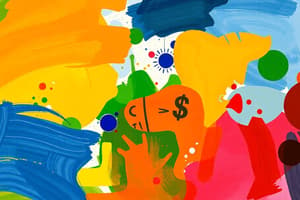Podcast
Questions and Answers
What does microeconomics primarily focus on?
What does microeconomics primarily focus on?
- Government policies and regulations
- Individual consumers and firms (correct)
- The overall economy and aggregate indicators
- International trade and its effects
Which market structure is characterized by a single seller dominating the market?
Which market structure is characterized by a single seller dominating the market?
- Perfect Competition
- Oligopoly
- Monopolistic Competition
- Monopoly (correct)
What is opportunity cost?
What is opportunity cost?
- The total costs incurred in producing a good
- The price of a good in a market
- The total revenue generated from sales
- The value of the next best alternative forgone (correct)
What does the inflation rate measure?
What does the inflation rate measure?
Which of the following is indicative of a mixed economy?
Which of the following is indicative of a mixed economy?
What role does monetary policy play in an economy?
What role does monetary policy play in an economy?
Which economic indicator reflects the total value of goods and services produced?
Which economic indicator reflects the total value of goods and services produced?
What does behavioral economics study?
What does behavioral economics study?
Flashcards are hidden until you start studying
Study Notes
Key Concepts in Economics
-
Definition of Economics
- Study of how societies allocate scarce resources to satisfy unlimited wants.
-
Branches of Economics
- Microeconomics
- Focuses on individual consumers and firms.
- Analyzes supply and demand, price formation, and market structures.
- Macroeconomics
- Examines the economy as a whole.
- Studies aggregate indicators like GDP, unemployment rates, and inflation.
- Microeconomics
-
Key Economic Concepts
- Scarcity
- Limited resource availability relative to unlimited human wants.
- Opportunity Cost
- Value of the next best alternative forgone when a choice is made.
- Supply and Demand
- Supply: Quantity of a good that producers are willing to sell at different prices.
- Demand: Quantity of a good that consumers are willing to buy at different prices.
- Scarcity
-
Market Structures
- Perfect Competition
- Many firms, identical products, easy entry and exit.
- Monopoly
- Single seller dominates the market, significant barriers to entry.
- Oligopoly
- Few firms, products may be identical or differentiated.
- Monopolistic Competition
- Many firms selling differentiated products, some control over price.
- Perfect Competition
-
Economic Indicators
- Gross Domestic Product (GDP)
- Total value of all goods and services produced in a country over a period.
- Inflation Rate
- Rate at which general price levels rise, eroding purchasing power.
- Unemployment Rate
- Percentage of the labor force that is jobless and actively seeking employment.
- Gross Domestic Product (GDP)
-
Fiscal Policy
- Government spending and taxation decisions aimed at influencing the economy.
- Tools include changes in tax rates and public spending.
-
Monetary Policy
- Central bank actions to control the money supply and interest rates.
- Aims to manage inflation and stabilize currency.
-
International Trade
- Exchange of goods and services across borders.
- Concepts include comparative advantage, trade barriers, tariffs, and quotas.
-
Economic Systems
- Capitalism
- Private ownership, market-driven economy.
- Socialism
- Public or collective ownership, controlled economic planning.
- Mixed Economy
- Combination of capitalism and socialism.
- Capitalism
-
Behavioral Economics
- Studies psychological factors influencing economic decisions and behaviors.
-
Development Economics
- Focuses on improving the economic conditions in developing countries.
-
Environmental Economics
- Examines the economic effects of environmental policies and resource management.
Definition of Economics
- Study of how societies use limited resources to satisfy unlimited wants.
Branches of Economics
- Microeconomics: Focuses on individual consumers and firms, analyzing topics like supply and demand, pricing, and market structures.
- Macroeconomics: Examines the economy as a whole, studying aggregate indicators like GDP, unemployment rates, and inflation.
Key Economic Concepts
- Scarcity: Limited resource availability relative to unlimited human wants.
- Opportunity Cost: Value of the next best alternative forgone when a choice is made.
- Supply and Demand:
- Supply: Quantity of a good producers are willing to sell at different prices.
- Demand: Quantity of a good consumers are willing to buy at different prices.
Market Structures
- Perfect Competition: Numerous firms selling identical products with easy entry and exit.
- Monopoly: Single seller dominates the market with significant barriers to entry.
- Oligopoly: Few firms with potentially identical or differentiated products.
- Monopolistic Competition: Many firms selling differentiated products with some control over pricing.
Economic Indicators
- Gross Domestic Product (GDP): Total value of all goods and services produced in a country over a period.
- Inflation Rate: Rate at which general price levels rise, eroding purchasing power.
- Unemployment Rate: Percentage of the labor force that is jobless and actively seeking employment.
Fiscal Policy
- Government spending and taxation decisions aimed at influencing the economy.
- Tools include changing tax rates and public spending levels.
Monetary Policy
- Central bank actions to control the money supply and interest rates, aiming to manage inflation and stabilize currency.
International Trade
- Exchange of goods and services across borders.
- Concepts include comparative advantage, trade barriers, tariffs, and quotas.
Economic Systems
- Capitalism: Private ownership and a market-driven economy.
- Socialism: Public or collective ownership with controlled economic planning.
- Mixed Economy: Combination of capitalism and socialist elements.
Behavioral Economics
- Studies psychological factors affecting economic decisions and behaviors.
Development Economics
- Focuses on improving economic conditions in developing countries.
Environmental Economics
- Examines the economic effects of environmental policies and resource management.
Studying That Suits You
Use AI to generate personalized quizzes and flashcards to suit your learning preferences.




